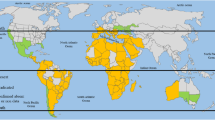Abstract
Laboratory studies were carried out to determine the effect of sex and age on the susceptibility of tsetse, Glossina morsitans morsitans and G. m. centralis, to the entomopathogenic fungus, Metarhizium anisopliae. Both species of host flies were susceptible to fungal infection. Female flies were generally more susceptible than male flies. Three host ages (40, 20, and <1 day-old) were used; the youngest group was most resistant to fungal infection. Interactions between species, sex and age were significant on many occasions. Age usually accounted for the largest variability in mortality, followed by sex. All flies of age 40 days died between 7 and 8 days after infection whereas some of the younger flies, especially age 0, lived longer than 10 days. Log10 day probit (LDP) mortality regressions fitted well to most of the data sets. LDP slopes were significant and high, ranging between 4.3 and 12.8, indicating a generally high mortality rate of increase over days. The slopes differed significantly between species, sexes, and ages, but grouping by age was more intra homogeneous than by species or sex. The 50% lethal time mortalities (LT50) ranged between 4 and 7 days for age 0, 3 and 6 days for age 20, and about 5 days for age 40. Corresponding ranges of the LT95 were 8 to 20, 5 to 10, and 6 to 7 days for ages 0, 20 and 40, respectively. The significance of these results in the fungal disease transmission by tsetse is discussed.
Similar content being viewed by others
References
Allsopp, R., 1984. Control of tsetse flies (Diptera: Glossinidae) using insecticides: a review and future prospects. Bull. of Entomol. Res. 74: 1–23.
Boucias, D.C., D.L. Bradford and C.S. Barfield, 1984. Susceptibility of the velvetbean caterpillar and soybean looper (Lepidoptera: Noctuidae) to Nomuraea rileyi: effects of pathotype, dosage, temperature, and host age. J. Econ. Entomol. 77: 247–253.
Bursell, E., 1961. The behaviour of tsetse flies (Glossina swynnertoni Austen) in relation to problems of sampling. Proc. Royal Entomol. Soc. London 36: 9–20.
Fargues, J. & D. Rodriguez-Rueda, 1980. Sensibilité des larves de Spodoptera littoralis (Lep.: Noctuidae) aux hyphomycètes entomopathogènes Nomuraea rileyi et Paecilomyces fumosoroseus. Entomophaga 25: 43–54.
Ferron, P., 1967. Essais préliminaires de la lutte contre les larves du hanneton commun, Melolontha melolontha L. à l'aide de la mycose a Beauveria tenella (Delacr.) Siemaszko. Phytiatrie-Phytopharmacie 16: 115–123.
Getsin, L.W., 1961. Spicaria rileyi (Farlow) Charles, an entomogenous fungus of Trichoplusia ni (Hubner). J. Invertebrate Pathology 3: 2–10.
Gitonga, W., 1996. Metarhizium anisopliae (Metschnikoff) Sorokin and Beauveria bassiana (Balsamo) Vuillemin as potential biological control agents of Macrotermes michaelseni (Sjostedt) (Isoptera: Termitidae) in Kenya. Ph.D. Thesis, Department of Ecology and Molecular Biology, Royal Veterinary and Agricultural University, Copenhagen, 144 pp.
Kaaya, G.P., 1989. Glossina morsitans morsitans: mortalities caused in adults by experimental infection with entomopathogenic fungi. Acta tropica. 46: 107–114.
Leak, S.G.A., W. Mulatu, G.J. Rowlands and G.D.M. D'Ieteren, 1995. A trial of a cypermethrin ‘pour-on’ insecticide to control Glossina pallidipes, G. fuscipes fuscipes and G. morsitans submorsitans (Diptera: Glossinidae) in south-west Ethiopia. Bull. Entomol. Res. 85: 241–251.
Maniania, N.K., 1991. Susceptibility of Chilo partellus (Swinhoe) (Lep., Pyralidae) eggs to entomopathogenic hyphomycetes. J. Appl. Entomol. 112: 53–58.
Maniania, N.K., 1992. Pathogenicity of entomogenous fungi (Hyphomycetes) to larvae of the stem borers, Chilo partelllus (Swinoe) and Busseola fusca Fuller. Insect Sci. Appl. 13: 691–696.
Maniania, N.K., 1994. A laboratory technique for infecting adult tsetse with fungal pathogen. Insect Sci. Appl. 15: 421–426.
Maniania, N.K., 1998. A device for infecting tsetse flies, Glossina spp., with entomopathogenic fungus in the field. Biol. Control 11: 248–254.
Mbulamberi, D.B., 1990. Recent epidemic outbreaks of Human trypanosomiasis in Uganda. Insect Sci. Appl. 11: 289–292.
Mohamed, A.K.A., P. Sikorowski and J.V. Bell, 1977. The susceptibility of Heliothis zea larvae to Nomuraea rileyi at various temperatures. J. Invertebrate Pathology 12: 444–459.
Mullens, B.A., 1985. Host, age, sex, and pathogen exposure level as factors in the susceptibility of Musca domestica to Entomophthora muscae. Entomol. Exp. Appl. 37: 33–39.
Randolph, S.E., D.J. Rogers, R.D. Dransfield and R. Brightwell, 1991. Trap-catches, nutritional condition and the timing of activity of the tsetse fly Glossina longipennis (Diptera: Glossinidae). Bull. Entomol. Res. 81: 455–464.
Rizzo, C.D., 1977. Age of three dipteran hosts as factor governing the pathogenicity of Beauveria bassiana and Metarhizium anisopliae. J. Invertebrate Pathology 30: 127–130.
Rogers, D.J., 1984. The estimation of sampling biases for male tsetse. Insect Sci. Appl. 5: 369–373.
Schaerffenberg, B., 1964. Biological and environmental conditions for the development of mycosis caused by Beauveria bassiana and Metarhizium anisopliae. J. Insect Pathology 6: 8–20.
Shereni, W., 1990. Strategic and tactical developments in tsetse control in Zimbabwe (1981– 1989). Insect Sci. Appl. 11: 399–409.
Tanada, Y. and R.J. Fuxa, 1987. The pathogen population. In: R.J. Fuxa and Y. Tanada (eds), Epizootiology of Insect Diseases. John Wiley & Sons, New York. pp. 113–157.
Throne, J.E., D.K. Weaver, V. Chew and J.R. Baker, 1995. Probit analysis of correlated data: multiple observation over time at one concentration. J. Econ. Entomol. 88: 1510–1512.
Veen, K.H., 1968. Recherches sur la maladie due à Metarhizum anisopliae chez le criquet pèlerin. Meded. Landbouwhogeschool Wageningen 68: 1–77.
Villecorta, A., 1983. Ovicidal activity of Metarhizium anisopliae isolate cm-14 on the coffee leaf miner Perileucoptera coffeela (Lep.: Lyonetiidae). Entomophaga 28: 179–184.
Watanabe, H., 1987. The host population. In: R.J. Fuxa and Y. Tanada (eds), Epizootiology of Insect Diseases. John Wiley & Sons, New York. pp. 71–112.
Zimmermann, G. 1982. Untersuchungen zur Wirkung von Metarhizium anisopliae (Metsch.) Sorok. auf Eier und Schlupfende Eilarven von Otiorhynchus sulcatus F. (Col., Curculionidae). Zeitsch. angew. Entomol. 93: 476–482.
Author information
Authors and Affiliations
Rights and permissions
About this article
Cite this article
Maniania, N.K., Odulaja, A. Effect of species, age, and sex of tsetse on response to infection by Metarhizium anisopliae. BioControl 43, 311–323 (1998). https://doi.org/10.1023/A:1009939711555
Issue Date:
DOI: https://doi.org/10.1023/A:1009939711555




